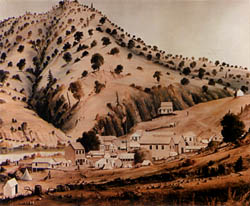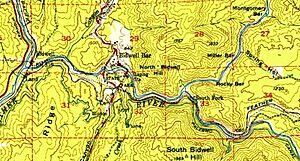Bidwell's Bar, California facts for kids
Quick facts for kids
Bidwell's Bar
|
|
|---|---|
|
Former settlement
|
|

Bidwell's Bar, c. 1854 (artist unknown)
|
|
| Country | United States |
| State | California |
| County | Butte County |
| Elevation | 902 ft (275 m) |
| Reference #: | 330 |
Bidwell's Bar was a busy gold mining town in California. It was located in Butte County, near the Feather River. This town was once a very important place during the California Gold Rush. It even marked the end of the famous California Trail.
Contents
Discovering Gold at Bidwell's Bar
The town of Bidwell's Bar was started by a man named John Bidwell. On July 4, 1848, he found gold near the Middle Fork of the Feather River. John Bidwell traded food with local Native Americans for the shiny yellow rocks. The Native Americans didn't value the gold much.
How the Mining Camp Grew
As news of the gold discovery spread, many miners came to the area. A mining camp quickly grew into a town. By 1853, Bidwell's Bar had enough people to open its own post office. The town's population grew to about 2,000 people. It became so important that it was chosen as the county seat for Butte County.
In 1854, a big fire destroyed much of the town. But the people quickly rebuilt it. By the late 1850s, Bidwell's Bar even had a special mail service. It was called Whiting's Dog Express. This service used trained dogs to deliver mail and supplies to different mining camps.
Life in the Gold Rush Town
Life in Bidwell's Bar was not easy. Many people lived in tents. A visitor in the 1850s called it a "rag city." Getting people and supplies across the river was also hard, especially in winter. So, money was collected to build a bridge.
Building the Bidwell Bar Bridge
The Bidwell Bar Bridge was the first suspension bridge built west of the Mississippi River. The first bridge was washed away by a flood in 1852. But a new, stronger bridge was finished in 1856. The town's post office operated from 1853 until 1900, with a short break from 1864 to 1865.
Why Bidwell's Bar Declined
Mining for gold was most successful in 1856 and 1857. However, the town's good times ended quickly. By the end of 1856, the gold started to run out. Miners began moving to a nearby town called Ophir, which is now Oroville.
The Town's Population Shrinks
The county seat also moved from Bidwell's Bar in 1856. Within a year, the town's population dropped to only 200 people. By 1882, just 30 people remained. The town slowly faded away.
What Remains Today
The last parts of Bidwell's Bar were covered by water in 1968. This happened when Lake Oroville was created. Today, only the original bridge and a clock tower are left. The clock tower is now in the Butte County Historical Museum. Another special survivor from the town is the Mother Orange Tree. This was the first orange tree planted in Northern California.
Historic Landmark Status
The area where Bidwell's Bar once stood is now recognized as a California Historical Landmark. This means it's an important historical site.
In Popular Culture
- Bidwell's Bar was featured as a place in the computer game Oregon Trail II.




